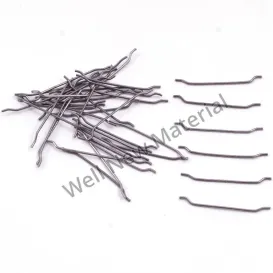Your Position: Home - Fiber Products - FAQs | Everything You Need to Know About Steel Fiber in Concrete
Steel fiber is a crucial material in the construction industry, providing significant advantages in enhancing the performance and durability of concrete. These small, discrete pieces of steel are integrated into concrete to improve its mechanical properties, resulting in stronger and more resilient structures. This article explores the benefits, applications, and considerations of using steel fiber in concrete, offering a comprehensive understanding for industry professionals and enthusiasts alike.
What is Steel Fiber?
Steel fiber consists of short, thin strands of steel that are mixed into concrete to enhance its properties. The fibers can take various shapes, such as straight, hooked, crimped, or twisted, with each contributing uniquely to the performance of the concrete. Typically manufactured from carbon steel or stainless steel, these fibers are incorporated into the concrete mix in different proportions based on the desired performance criteria.

How Does Steel Fiber Enhance Concrete?
Steel fibers enhance concrete in several significant ways:
Improved Tensile Strength: Steel fibers increase the tensile strength of concrete, which is inherently weak in tension, making it more resistant to cracking and splitting under stress.
Enhanced Flexural Strength: By distributing stress more evenly throughout the concrete, steel fibers enhance its flexural strength, allowing it to bend without breaking.
Increased Durability: Steel fibers help prevent the formation of micro-cracks and control the propagation of larger cracks, significantly boosting the durability and lifespan of concrete structures.
Better Impact Resistance: Concrete reinforced with steel fibers can absorb and dissipate energy more effectively, thereby improving its resistance to impact and dynamic loads.
Reduced Shrinkage and Creep: Steel fibers reduce shrinkage and creep in concrete, helping maintain its shape and structural integrity over time.
Applications of Steel Fiber in Concrete
Steel fiber finds application across various sectors in the construction industry, including:
Industrial Floors: Steel fiber-reinforced concrete is well-suited for industrial floors due to its high strength and durability, capable of withstanding heavy loads and continuous use.
Pavements and Overlays: The enhanced properties of steel fiber-reinforced concrete make it ideal for pavements and overlays, providing longer lifespans and reduced maintenance costs.
Shotcrete: In tunneling and mining, steel fiber-reinforced shotcrete offers improved support and stability, minimizing collapse risks.
Precast Concrete Products: Steel fibers are used in precast concrete products such as pipes, tanks, and panels, enhancing their strength and durability.
Bridges and Tunnels: The high strength and durability of steel fiber-reinforced concrete make it perfect for use in bridges and tunnels, where structural integrity is critical.
How to Determine the Right Proportion of Steel Fiber
The optimal proportion of steel fiber to add to concrete depends on various factors, including the desired mechanical properties, specific application, and mix design. Generally, fiber content varies from 0.25% to 2.5% by volume of concrete. Conducting thorough testing and consulting relevant standards is crucial to determine the appropriate fiber content for each specific application.
Mixing and Placing Steel Fiber-Reinforced Concrete
Correct mixing and placement techniques are vital for achieving the desired properties of steel fiber-reinforced concrete:
Mixing: Ensure uniform distribution of fibers throughout the concrete mix for consistent performance. Standard mixing equipment may be adjusted to accommodate fiber addition.
Placing: Care must be taken during placement to prevent fiber segregation and ensure even distribution. Standard concrete placement techniques can be employed, with additional compaction methods if needed.
Finishing: Finishing steel fiber-reinforced concrete can follow traditional methods; however, extra caution is necessary to avoid pulling fibers to the surface and to achieve a smooth finish.
Benefits of Using Steel Fiber in Concrete
The advantages of incorporating steel fiber in concrete are numerous:
Enhanced Structural Performance: Steel fibers improve the overall structural performance of concrete, resulting in a stronger and more resilient material.
Cost-Effective: Although the initial cost of steel fibers may be higher, long-term savings through reduced maintenance and extended lifespan make it a cost-effective solution.
Versatility: Steel fiber-reinforced concrete can be employed in various applications, from industrial floors to precast products, offering design and construction flexibility.
Sustainability: Utilizing steel fibers contributes to sustainable construction practices by minimizing the need for additional reinforcement and prolonging the lifespan of concrete structures.
Challenges and Considerations
Despite its many advantages, some challenges and considerations exist when using steel fiber in concrete:
Cost: The initial investment for steel fibers can exceed that of traditional reinforcement methods, which may be a concern for budget-sensitive projects.
Workability: Fiber addition can affect concrete workability, making it stiffer and more challenging to place and finish. Proper mix design and placement techniques are essential to address this issue.
Corrosion: While stainless steel fibers resist corrosion effectively, carbon steel fibers may be susceptible in aggressive environments. It is vital to take protective measures to ensure long-term durability.
Conclusion
Steel fiber is a valuable addition to concrete, providing significant enhancements in strength, durability, and performance. Understanding the properties, applications, and considerations of steel fiber allows construction professionals to optimize their concrete mixes for a variety of projects. When managed correctly, steel fiber-reinforced concrete presents a cost-effective, versatile, and sustainable solution for modern construction needs.
98
0
0
Previous: None
Next: none
Comments
All Comments (0)